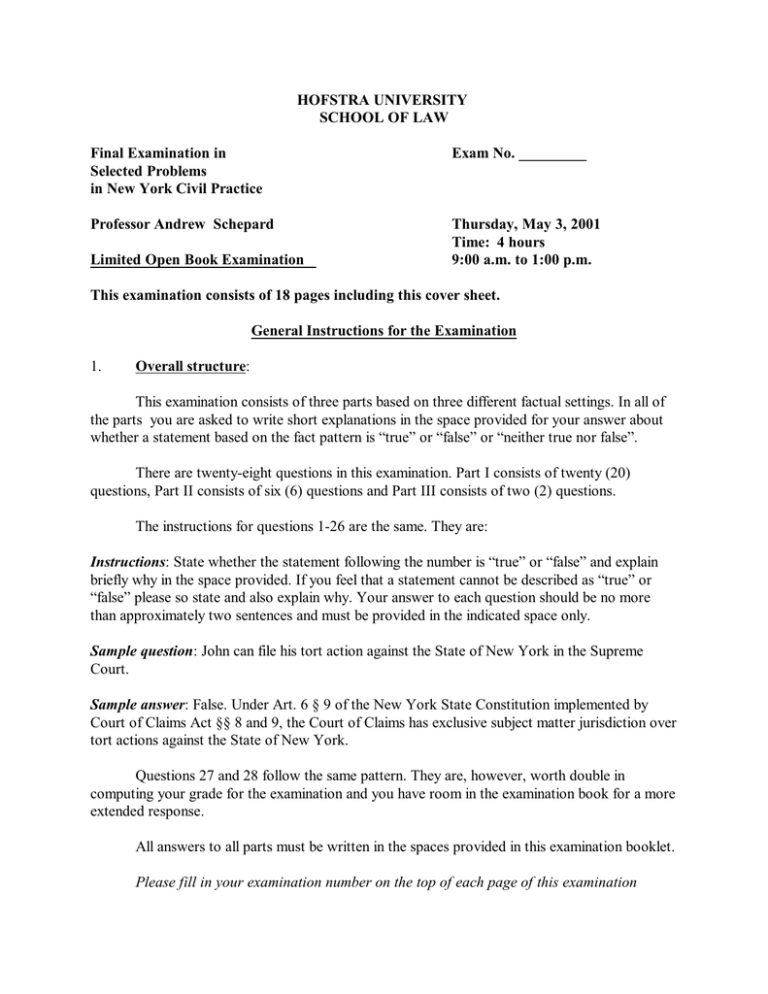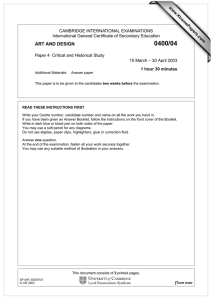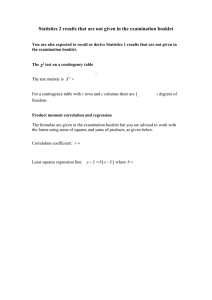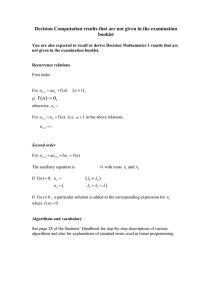HOFSTRA UNIVERSITY SCHOOL OF LAW Final Examination in Exam No. _________
advertisement

HOFSTRA UNIVERSITY SCHOOL OF LAW Final Examination in Selected Problems in New York Civil Practice Exam No. _________ Professor Andrew Schepard Thursday, May 3, 2001 Time: 4 hours 9:00 a.m. to 1:00 p.m. Limited Open Book Examination This examination consists of 18 pages including this cover sheet. General Instructions for the Examination 1. Overall structure: This examination consists of three parts based on three different factual settings. In all of the parts you are asked to write short explanations in the space provided for your answer about whether a statement based on the fact pattern is “true” or “false” or “neither true nor false”. There are twenty-eight questions in this examination. Part I consists of twenty (20) questions, Part II consists of six (6) questions and Part III consists of two (2) questions. The instructions for questions 1-26 are the same. They are: Instructions: State whether the statement following the number is “true” or “false” and explain briefly why in the space provided. If you feel that a statement cannot be described as “true” or “false” please so state and also explain why. Your answer to each question should be no more than approximately two sentences and must be provided in the indicated space only. Sample question: John can file his tort action against the State of New York in the Supreme Court. Sample answer: False. Under Art. 6 § 9 of the New York State Constitution implemented by Court of Claims Act §§ 8 and 9, the Court of Claims has exclusive subject matter jurisdiction over tort actions against the State of New York. Questions 27 and 28 follow the same pattern. They are, however, worth double in computing your grade for the examination and you have room in the examination book for a more extended response. All answers to all parts must be written in the spaces provided in this examination booklet. Please fill in your examination number on the top of each page of this examination Exam Number (fill in here on each page of the Examination Booklet): __________ Problems in New York Civil Practice – Spring 2001 Examination Booklet Page 2 booklet right now. You will return the entire examination booklet at the end of the examination. 2. Length, Grading Weight, Overall Time Limit and Suggested Time Allocation This examination is four hours (240 minutes). The maximum possible numerical score on this examination is one hundred fifty (150) points. Your answers to Questions 1-26 are each worth a maximum of five (5) points in your total numerical score. Your answers to Questions 27 and 28 are each worth a maximum of ten (10) points in your total numerical score. The following is thus the recommended allocation of time for answering this examination: Part I - 20 questions - 100 points maximum - 66% of total score - 160 minutes Part II - 6 questions - 30 points maximum - 20% of total score - 48 minutes Part III - 2 questions - 20 points maximum - 14% of total score - 32 minutes 3. Answers in the Examination Booklet All questions on this examination MUST be answered in the spaces provided in this examination booklet. Answers written in other places will not be read. Please write legibly. You may use scrap paper, but you must hand it in to the proctor in charge at the end of the examination. 4. Instructions for Computer Users Computer users typing their examinations must clearly label which question they are answering and adhere to a limitation of : Questions 1-26: 600 characters each Questions 27-28: 1200 characters each 5. After You Complete the Examination: At the end of the examination you must turn in THIS EXAMINATION BOOKLET. All examinations must be handed to the secretary or proctor in charge of this examination. You must sign out in his or her presence. Please write your name, examination number and the title and section of the course on the attached card. The card should be returned with the examination itself. Exam Number (fill in here on each page of the Examination Booklet): __________ Problems in New York Civil Practice – Spring 2001 Examination Booklet Page 3 6. What You Can Bring Into the Examination With You: This is a limited open book examination. You are required to bring the one volume edition of the CPLR which you purchased for the course, into the examination room with you. You may bring into the examination ONLY the following: the Chase and Barker Casebook; the Syllabus and Supplementary Materials for the Course; any additional materials handed out during the semester or downloaded from the Course Website; Siegel's New York Practice (one volume edition) and the Supplement thereto, and your own personal notes. You can also bring into the examination outlines prepared for the course by individuals or study groups but which have not been commercially purchased by you. You cannot bring in prepared outlines that you have purchased from someone else, either commercially or privately. 7. Governing Law and Assumptions For This Examination: Please remember that this is a course in New York civil practice. Focus your analysis, references and answers on the CPLR and the New York cases, statutes and rules that we studied, and not simply general statements of civil procedure or the Federal Rules of Civil Procedure. If you believe you need any additional information to answer a question, explain what information you need and why you believe you need it. 8. Calendar A calendar for 2001 is attached as the last page of the Examination Booklet for your use. Part I Questions 1- 20 are based on the following facts as amplified by the additional assumptions sometimes provided before a question: While in the custody of the New York City Department of Corrections at Rikers Island awaiting trial, plaintiff James Richter (“Richter”) was seriously injured by another inmate who was transferred into his cell. Richter commences an action against the City of New York in Supreme Court of New York County. (“New York City Damages Action”) to recover damages based on a claim that the City was negligent in supervising prison operations because the inmate it put into the cell with Richter had known tendencies to physical violence. Assume that Richter’s injury occurs on January 1, 2000 and that the applicable statute of Exam Number (fill in here on each page of the Examination Booklet): __________ Problems in New York Civil Practice – Spring 2001 Examination Booklet Page 4 limitation is one year and thus expires on December 31, 2000. 1. Richter must purchase an index number for the summons and complaint in the New York City Damages Action from the Clerk of the Supreme Court of New York County by December 31, 2000. _________________________________________________________________ _________________________________________________________________ _________________________________________________________________ _________________________________________________________________ _________________________________________________________________ _________________________________________________________________ Assume that Richter timely commences the New York City Damages Action on December 31, 2000. 2. Richter must serve the summons and complaint with the index number on the City by April 30, 2001. _________________________________________________________________ _________________________________________________________________ _________________________________________________________________ _________________________________________________________________ _________________________________________________________________ _________________________________________________________________ 3. Richter must file proof of service of the summons and complaint on the City in the New York City Damages on the City by April 30, 2001. _________________________________________________________________ _________________________________________________________________ Exam Number (fill in here on each page of the Examination Booklet): __________ Problems in New York Civil Practice – Spring 2001 Examination Booklet Page 5 _________________________________________________________________ _________________________________________________________________ _________________________________________________________________ _________________________________________________________________ Assume that after being served with the summons and complaint in the New York City Damages Action, the City wants to move to dismiss the complaint. 4. The Supreme Court should grant the City’s motion to dismiss the New York City Damages Action for lack of subject matter jurisdiction. _________________________________________________________________ _________________________________________________________________ _________________________________________________________________ _________________________________________________________________ _________________________________________________________________ _________________________________________________________________ Assume that the City also moves to dismiss the New York City Damages Action on the grounds that service of the summons and complaint was accomplished after the applicable time period expired. 5. The City should bring on the motion to dismiss the complaint by order to show cause. _________________________________________________________________ _________________________________________________________________ _________________________________________________________________ _________________________________________________________________ _________________________________________________________________ _________________________________________________________________ Exam Number (fill in here on each page of the Examination Booklet): __________ Problems in New York Civil Practice – Spring 2001 Examination Booklet Page 6 ______________________________________________________________________________ Assume the City properly serves its motion to dismiss the Complaint on Richter. Assume the return date for the City’s motion is May 3, 2001. 6. Richter can cross move to extend his time to serve the Complaint in the New York City Damages Action by serving the cross motion by mail on the City by April 25, 2001. _________________________________________________________________ _________________________________________________________________ _________________________________________________________________ _________________________________________________________________ _________________________________________________________________ _________________________________________________________________ 7. Richter’s lawyer cannot file an affirmation in opposition to the City’s motion describing the efforts he directed to serve the summons and complaint on the City. _________________________________________________________________ _________________________________________________________________ _________________________________________________________________ _________________________________________________________________ _________________________________________________________________ _________________________________________________________________ 8. The court cannot consider the potential merit of Richter’s claim in the New York City Damages Action in determining whether Richter’s time to serve the summons and complaint should be extended. _________________________________________________________________ Exam Number (fill in here on each page of the Examination Booklet): __________ Problems in New York Civil Practice – Spring 2001 Examination Booklet Page 7 _________________________________________________________________ _________________________________________________________________ _________________________________________________________________ _________________________________________________________________ _________________________________________________________________ Assume that the City’s motion to dismiss the complaint is granted. 9. Richter must serve notice of entry of the order dismissing the New York City Damages Action on the City within thirty days of its entry by the clerk. _________________________________________________________________ _________________________________________________________________ _________________________________________________________________ _________________________________________________________________ _________________________________________________________________ _________________________________________________________________ Assume that the supreme court denies the City’s motion to dismiss the New York City Damages Action. 10. The City can appeal the order of the trial court to the Appellate Division, First Department. _________________________________________________________________ _________________________________________________________________ _________________________________________________________________ _________________________________________________________________ _________________________________________________________________ Exam Number (fill in here on each page of the Examination Booklet): __________ Problems in New York Civil Practice – Spring 2001 Examination Booklet Page 8 Assume that the supreme court grants the City’s motion to dismiss and the Appellate Division unanimously affirms the order of the Supreme Court dismissing Richter’s Complaint. 11. Richter can appeal as of right to the Court of Appeals from the order of the Appellate Division. _________________________________________________________________ _________________________________________________________________ _________________________________________________________________ _________________________________________________________________ _________________________________________________________________ _________________________________________________________________ Assume that after appropriate service of notice of entry of the order of dismissal by the Supreme Court Richter learns that the process server’s secretary is willing to sign an affidavit that the process server was in a drug rehabilitation program during the entire period that process should have been served on the City in the New York City Damages Action. 12. Richter must file a motion bringing this information to the attention of the Supreme Court within thirty days of service of notice of entry of the order dismissing the New York City Damages Action. _________________________________________________________________ _________________________________________________________________ _________________________________________________________________ _________________________________________________________________ _________________________________________________________________ _________________________________________________________________ Assume that after the City’s motion to dismiss the New York City Damages Action is granted and affirmed on appeal, Richter commences an action in the Supreme Court, New York County against one Robert Zap (“Zap”). In this action (“the Zap Malpractice Action”) Richter Exam Number (fill in here on each page of the Examination Booklet): __________ Problems in New York Civil Practice – Spring 2001 Examination Booklet Page 9 alleges that Zap agreed to represent Richter in the New York City Damages Action and committed malpractice by failing to commence the Action and serve the summons and complaint on the City within the applicable time periods. Zap is a general practitioner who represented Richter on a prior criminal charge. Zap is a member of the New Jersey bar as well as the New York bar. Zap has, however, relocated his practice to New Jersey and for the last four years has not represented a client before the courts of New York. He closed his New York office entirely and is located in Morristown, New Jersey. Zap moves to dismiss the complaint in the Zap Malpractice Action. The affidavits in support of and opposition to the motion reveal the following additional facts: Richter called Zap in New Jersey from prison at Riker’s Island. Richter contends that, during that telephone conversation, Zap agreed to represent him in the New York City Damages Action. Zap, however, claims that all he said to Richter during the conversation is that he needed a New York attorney to represent him and gave Richter the names of several possible attorneys. Zap’s name and signature does not appear on any of the pleadings in Richter’s lawsuit against the City. Assume for purposes of this portion of your answer that the court papers show Richter as representing himself in the New York City Damages Action. One subsequent day, Zap received a phone call at his office in New Jersey from a woman who said she was Richter's sister. She told him that she had a personal and confidential letter from Richter to Zap which Richter asked her to deliver to Zap personally since he (Richter) did not trust the prison mail system. Although he had no other reason to be in New York that day, Zap drove over the George Washington Bridge to the Manhattan side to 178th Street and Broadway where he agreed to meet the woman. Once Zap arrived, a woman approached his car. He rolled down the window. The woman handed him a plain, unmarked envelope containing a summons and complaint for the Zap Malpractice Action. 13. Venue of the Zap Malpractice Action is proper in Supreme Court, New York County. ______________________________________________________________________________ ______________________________________________________________________________ ______________________________________________________________________________ ______________________________________________________________________________ Exam Number (fill in here on each page of the Examination Booklet): __________ Problems in New York Civil Practice – Spring 2001 Examination Booklet Page 10 ______________________________________________________________________________ ______________________________________________________________________________ 14. In deciding Zap’s motion to dismiss, the court can rely on a summary of what Richter’s sister told him about service of the summons and complaint on Zap contained in Richter’s answering affidavit. _________________________________________________________________ _________________________________________________________________ _________________________________________________________________ _________________________________________________________________ _________________________________________________________________ _________________________________________________________________ 15. The court can allow Zap to take the deposition of Richter’s sister before resolving Zap’s motion to dismiss the complaint. _________________________________________________________________ _________________________________________________________________ _________________________________________________________________ _________________________________________________________________ _________________________________________________________________ _________________________________________________________________ Assume the court credits Richter’s version of the telephone conversation between Richter and Zap. 16. Zap’s motion to dismiss the complaint in the Zap Malpractice Action for lack of personal jurisdiction should be denied because he was served with the summons and complaint in New York. Exam Number (fill in here on each page of the Examination Booklet): __________ Problems in New York Civil Practice – Spring 2001 Examination Booklet Page 11 _________________________________________________________________ _________________________________________________________________ _________________________________________________________________ _________________________________________________________________ _________________________________________________________________ _________________________________________________________________ 17. Since Zap was served with the summons and complaint in New York the court will reject an argument by him that the Zap Malpractice Action should be dismissed because New York lacks “minimum contacts” for personal jurisdiction over him. _________________________________________________________________ _________________________________________________________________ _________________________________________________________________ _________________________________________________________________ _________________________________________________________________ _________________________________________________________________ 18. The Supreme Court has personal jurisdiction to render a judgment against Zap in the Zap Malpractice Action because he is a member of the New York bar. _________________________________________________________________ _________________________________________________________________ _________________________________________________________________ _________________________________________________________________ _________________________________________________________________ _________________________________________________________________ 19. Zap’s motion to dismiss the complaint for lack of personal jurisdiction should be denied Exam Number (fill in here on each page of the Examination Booklet): __________ Problems in New York Civil Practice – Spring 2001 Examination Booklet Page 12 because Zap “transacted business” in New York. _________________________________________________________________ _________________________________________________________________ _________________________________________________________________ _________________________________________________________________ _________________________________________________________________ _________________________________________________________________ 20. The court should grant a motion by Zap to dismiss the case under CPLR § 327 in favor of litigation in New Jersey. _________________________________________________________________ _________________________________________________________________ _________________________________________________________________ _________________________________________________________________ _________________________________________________________________ _________________________________________________________________ Part II Questions 20-26 are based on the following facts as amplified by the additional facts set out before a particular question. New York State law states that only a licensed real estate broker can earn a commission for assisting in the purchase or sale of real estate. By written contract, one Harvey Werth engaged the services of one Joan Rivilin to assist in the acquisition of a nursing home in Buffalo, New York. The contract refers to the services to be rendered as assisting in "the purchase, lease or management of a nursing home facility". The contract provides for a commission to be paid to Rivilin at the conclusion of the Exam Number (fill in here on each page of the Examination Booklet): __________ Problems in New York Civil Practice – Spring 2001 Examination Booklet Page 13 transaction. It also contains the following clause: "New York law shall determine the rights and liabilities of the parties to this agreement. Any and all disputes relating to the interpretation or application of this contract shall be resolved by arbitration under the Rules for Commercial Arbitration of the American Arbitration Association then in effect. The arbitration shall take place in New York City." Werth, in fact, ultimately acquired the Buffalo nursing home with Rivilin’s assistance. He acquired the land, the building, the furniture and equipment, operating license, patient list, employment contracts and good will. Rivilin, however, is not a licensed real estate broker. Before she signed the written brokerage contract with Werth, she falsely represented to him that she was. When Werth learned that Rivilin was not a licensed real estate broker, he refused to pay her the commission due on the nursing home transaction. Werth also told a potential client of Rivilin that she was "a fraud and a liar". Rivilin believes that Werth’s statement cost her a chance at a potentially lucrative commission. Assume Rivilin wants to make the following claims against Werth: (1) for a commission from the nursing home transaction; (2) for defamation based on the statements to the potential client. She wants to seek compensatory and punitive damages. Werth would rather have these claims resolved in litigation and files litigation in Supreme Court, New York County for a declaratory judgment that Rivilin is not entitled to a commission on the sale of the nursing home transaction. 21. Rivilin should immediately take Werth’s deposition in the litigation commenced by Werth. _________________________________________________________________ _________________________________________________________________ _________________________________________________________________ _________________________________________________________________ _________________________________________________________________ Exam Number (fill in here on each page of the Examination Booklet): __________ Problems in New York Civil Practice – Spring 2001 Examination Booklet Page 14 _________________________________________________________________ 22. Werth is likely to defeat Rivilin’s attempts to compel arbitration by arguing that any arbitration award to Rivilin would violate public policy. _________________________________________________________________ _________________________________________________________________ _________________________________________________________________ _________________________________________________________________ _________________________________________________________________ _________________________________________________________________ 23. Werth is likely to exclude Rivilin’s claim for defamation from the arbitration proceeding. _________________________________________________________________ _________________________________________________________________ _________________________________________________________________ _________________________________________________________________ _________________________________________________________________ _________________________________________________________________ Assume that arbitration is compelled and the arbitration takes place. 24. Rivilin can testify about what her prospective client told her about Werth said about her. _________________________________________________________________ _________________________________________________________________ _________________________________________________________________ Exam Number (fill in here on each page of the Examination Booklet): __________ Problems in New York Civil Practice – Spring 2001 Examination Booklet Page 15 _________________________________________________________________ _________________________________________________________________ Assume the arbitrator awards Rivilin substantial compensatory and punitive damages. The arbitrator’s award is delivered to Werth on February 1, 2001. 25. If Werth does not commence a proceeding to vacate the arbitration award by May 2, 2001 he will precluded from raising arguments to the court that the arbitrator’s award violates public policy. _________________________________________________________________ _________________________________________________________________ _________________________________________________________________ _________________________________________________________________ _________________________________________________________________ _________________________________________________________________ 26. Werth must purchase a new index number to challenge the arbitration award. _________________________________________________________________ _________________________________________________________________ _________________________________________________________________ _________________________________________________________________ _________________________________________________________________ _________________________________________________________________ Part III Questions 27-28 are based on the following factual setting: Exam Number (fill in here on each page of the Examination Booklet): __________ Problems in New York Civil Practice – Spring 2001 Examination Booklet Page 16 Albany Children's Academy Charter School Inc.(“Charter School”) has applied to the Board of Trustees of the State University of New York (“SUNY Trustees”) for a charter authorized by New York’s Charter Schools Act (the “Act”). to operate a new school in Albany County. The Albany County School Board (“School Board”) is the governing body of the Albany County School District (“District”). The District consists primarily of minority students and has been plagued with curriculum and financial problems. It has been operating on an austerity budget since 1999. The School Board steadfastly maintains that the operation of a charter school within the District's boundaries will exacerbate its financial problems and will have a devastating impact upon the District's ability to provide educational programs and services to those students who continue to be enrolled in its public schools. The following are key provisions of the Act: (1) The SUNY Trustees are the "charter entity" to which a proposed charter school submits an application. The SUNY Trustees conduct an investigation of the application. An applicant must include evidence of adequate community support sufficient to allow the school to reach its anticipated enrollment, and an assessment of the projected programmatic and fiscal impact of the school on other public and nonpublic schools in the area. Upon approval of an application by the SUNY Trustees, the applicant and the SUNY Trustees enter into a proposed agreement allowing the applicant to organize and operate a charter school. This agreement is itself the "charter". (2) The Board of Regents of the State of New York (the “Regents”) is the only entity authorized to actually issue a charter. The Regents set regulations for the operations of schools in New York State. Within five days of entering into a charter with the SUNY Trustees, the applicant submit a copy of it, the application and any supporting documentation for final approval and issuance of the charter by the Board of Regents. (3) The "authority" of the Board of Regents to "approve" a proposed charter is, however, circumscribed. Although the statutory scheme mandates that the Board of Regents be given an opportunity to review a proposed charter it does not actually provide authority for the Board of Regents to reject or veto it. Rather, upon receipt of a charter, the Board of Regents has the option of approving it as proposed or returning it to the applicant for reconsideration with written comments and recommendations. The Act specifies no time limit for the Board of Regents to act on a proposed charter. Assume the SUNY Trustees entered into a charter with the Charter School on January 5, 2001. The School District claims that the Charter’s Schools application contains insufficient evidence of community support and inaccurate representations about the financial consequences that the Charter School would have on the School District and its residents. Exam Number (fill in here on each page of the Examination Booklet): __________ Problems in New York Civil Practice – Spring 2001 Examination Booklet Page 17 27. The School District will likely be successful in an Article 78 proceeding against the SUNY Trustees. _________________________________________________________________ _________________________________________________________________ _________________________________________________________________ _________________________________________________________________ _________________________________________________________________ _________________________________________________________________ _________________________________________________________________ _________________________________________________________________ _________________________________________________________________ _________________________________________________________________ _________________________________________________________________ _________________________________________________________________ Assume that the Charter School submitted the proposed charter to the Board of Regents on January 5, 2001. The Board of Regents has taken no action on the charter up to this date. The Charter School is concerned that the School District and its allies on the Board of Regents who do not like the idea of charter schools are trying to withhold action as long as possible. 28. The Charter School will likely be successful in an Article 78 proceeding against the Board of Regents. _________________________________________________________________ _________________________________________________________________ _________________________________________________________________ _________________________________________________________________ Exam Number (fill in here on each page of the Examination Booklet): __________ Problems in New York Civil Practice – Spring 2001 Examination Booklet Page 18 _________________________________________________________________ _________________________________________________________________ ______________________________________________________________________________ ______________________________________________________________________________ ______________________________________________________________________________


